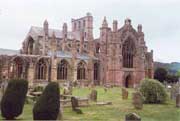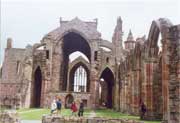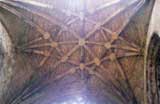Melrose Abbey
 There has been a monastery at Melrose, or Mailros, since about 650AD. The first monastery was founded here by St Aidan of Lindisfarne and monks came from St Columba's monastery on Iona. This monastery was located in a loop in the River Tweed two miles to the east of today's Melrose, now known as Old Melrose.
There has been a monastery at Melrose, or Mailros, since about 650AD. The first monastery was founded here by St Aidan of Lindisfarne and monks came from St Columba's monastery on Iona. This monastery was located in a loop in the River Tweed two miles to the east of today's Melrose, now known as Old Melrose.
The Abbey was founded 1136 by David I for Abbott Richard and his Cistercian Monks from Rievaulx Abbey in Yorkshire. By end of 14th century much of the original simple church had been destroyed by the English, in the wars of independence.
The subsequent rebuilding was helped greatly by the generosity of Robert the Bruce. His embalmed heart, encased in lead, is buried at Melrose Abbey.
 The replacement was far from austere, grandly and lavishly ornamented with capitals, bosses and corbels, carved with fruit, flowers and foliage and numerous statues – a cook with his ladle, mason with his mallet, the fat monk- even a bagpipe playing pig. It is comparable to Roslin Chapel and represents the high point of the decorated period in Scotland.
The replacement was far from austere, grandly and lavishly ornamented with capitals, bosses and corbels, carved with fruit, flowers and foliage and numerous statues – a cook with his ladle, mason with his mallet, the fat monk- even a bagpipe playing pig. It is comparable to Roslin Chapel and represents the high point of the decorated period in Scotland.
 In 1385 the abbey was again ravished by the English (though the aggression was started by the Scots). Over a hundred years of reconstruction followed. Virtually everything on view today can be dated back to this period. The English returned again in 1544 this time in support of efforts by Henry VIII to persuade the Scots to betroth the infant Mary Queen of Scots to his son. (The rough wooing.) Melrose and its abbey were both badly damaged. It never recovered for the reformation came and the age of abbeys was over.
In 1385 the abbey was again ravished by the English (though the aggression was started by the Scots). Over a hundred years of reconstruction followed. Virtually everything on view today can be dated back to this period. The English returned again in 1544 this time in support of efforts by Henry VIII to persuade the Scots to betroth the infant Mary Queen of Scots to his son. (The rough wooing.) Melrose and its abbey were both badly damaged. It never recovered for the reformation came and the age of abbeys was over.
 The monastic buildings are on the North side of the church in order to use the waters of the Tweed for drainage purposes. Melrose is in a bend in the river and it was not too difficult to cut a water channel thought the grounds of the abbey. The water powered the corn mill and from it water was diverted for sanitation.
The monastic buildings are on the North side of the church in order to use the waters of the Tweed for drainage purposes. Melrose is in a bend in the river and it was not too difficult to cut a water channel thought the grounds of the abbey. The water powered the corn mill and from it water was diverted for sanitation.
In 1610 part of the central portion of the nave of the Abbey Church was converted into a parish church for Melrose with end walls and windows inserted into the existing structure. This continued in use until replaced by a new church elsewhere in Melrose in 1810.
At the north end is the Commendator's House, now a museum.